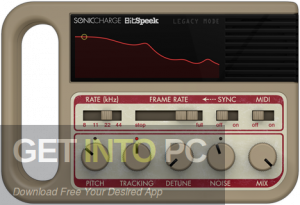

FLIP L/R With FLIP L/R you can switch the left and right feedback channels so that for each iteration the audio will bounce from left to right and vice versa. FEEDBACK AMOUNT The FEEDBACK AMOUNT knob determines how much of the output signal is fed back into the input again. The different placement settings can make a big difference to the sound if you have a lot of digital distortion going on. If you turn the level high you will either get a lot of distortion or make the limiter work harder and obtain a more compact sound. "bit crushing" (compensate with a high OUTPUT LEVEL). If you turn INPUT LEVEL very low you will introduce a lot of quantization noise, i.e. If SYNC is OFF, the clock frequency goes from 0 Hz (full stop) all the way up to 352.8 kHz.Īnalog Section INPUT LEVEL INPUT LEVEL is applied before anything else, including the soft clipper, the limiter and converting to 12-bit sample data. The greater the frequency, the brighter and clearer the sound, but the maximum delay time will also be shorter. Changing the rate affects both the audio quality and the speed and delay times of the effects. Memory Control CLOCK FREQ The CLOCK FREQ knob sets the running rate of the instructions. It uses the same exponential scale as SUB. The SUBTRACT operand lets you delay the output signal. When a bit is zero (switch is down), Instruction 1 is ignored. if CLOCK FREQ is set to 1/1, each bit represents an eighth note.
SONIC CHARGE PERMUT8 FULL
Each bit in the STEP MASK operand represents an eighth of the full "memory cycle", i.e. MSK Use MSK to selectively "mask out" the result of instruction 1. A rate of 00 will freeze the oscillation and turn this operator into a fixed delay. The highest (leftmost) bit can be turned on to achieve a wide stereo effect by inverting the modulation of the right audio channel. The high operand sets the rate of the oscillation and the low operand sets the magnitude / depth of the modulation. Flanger effects can also be achieved by turning up the FEEDBACK amount. MUL MUL changes the rate of the read position in relation to the write position.Įxtreme frequency modulation. The middle bits generate granular "buffer underrun" effects while the lowest bits can be flipped to achieve "aliasing" like from a bit-crusher effect. Turn on SYNC and flip the higher (leftmost) bits to create beat-repeating effects.

It works by clearing selected bits in the read position data word. Operators AND The AND operator creates sudden jumps with the read position. Use the two instructions to change and modulate the read positions with different "operators". The green dots represent playback positions for left and right outputs, i.e. The red dot shows incoming audio that is written to memory, i.e. User Interface The heart of Permut8 is the 128 kilowords 12-bit memory, visualized by the LED array at the bottom of the user interface. At its core is a 12-bit digital delay with variable sample rate from 0 to 352 khz.

It is programmable to produce a wide range of effects from traditional delays and flangers to beat-repeaters, bit-crushers and yet unheard of circuit bent madness. INTRODUCTION Permut8 is an effect plug-in that embraces the sounds of primitive digital signal processing hardware.


 0 kommentar(er)
0 kommentar(er)
